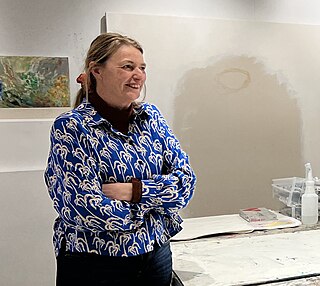
The Queensland Art Gallery (QAG) is an art museum located in South Bank, Brisbane, Queensland, Australia. The gallery is part of QAGOMA. It complements the Gallery of Modern Art (GOMA) building, situated only 150 metres (490 ft) away.

Ben Quilty is an Australian artist and social commentator, who has won a series of painting prizes: the 2014 Prudential Eye Award, 2011 Archibald Prize, and 2009 Doug Moran National Portrait Prize. He has been described as one of Australia's most famous living artists.

The Gallery of Modern Art (GOMA) is an art museum located within the Queensland Cultural Centre in the South Bank precinct of Brisbane, Queensland, Australia. The gallery is part of QAGOMA.
Kumantje Jagamara, also known as Kumantje Nelson Jagamara, Michael Minjina Nelson Tjakamarra, Michael Nelson Tjakamarra and variations, was an Aboriginal Australian painter. He was one of the most significant proponents of the Western Desert art movement, an early style of contemporary Indigenous Australian art.

Shigeyuki "Yuki" Kihara is an interdisciplinary artist of Japanese and Samoan descent. In 2008, her work was the subject of a solo exhibition at the Metropolitan Museum of Art in New York; it was the first time a New Zealander and the first time a Pacific Islander had a solo show at the institution. Titled Shigeyuki Kihara: Living Photographs, the exhibition opened from 7 October 2008 to 1 February 2009. Kihara's self-portrait photographs in the exhibitions included nudes in poses that portrayed colonial images of Polynesian people as sexual objects. Her exhibition was followed by an acquisition of Kihara's work for the museum's collection.
Saskia Leek is a New Zealand painter.

Séraphine Pick is a New Zealand painter. Pick has exhibited frequently at New Zealand public art galleries; a major survey of her work was organised and toured by the Christchurch Art Gallery in 2009–10.

Dame Robin Adair White is a New Zealand painter and printmaker, recognised as a key figure in the regionalist movement of 20th-century New Zealand art.
Joanna Margaret Paul was a New Zealand visual artist, poet and film-maker.

The Queensland Art Gallery and Gallery of Modern Art, colloquially known as QAGOMA, is an art museum in Brisbane, Queensland, Australia. It consists of the Queensland Art Gallery (QAG), which is the main building, and a second gallery, the Gallery of Modern Art (GOMA), situated 150 m (490 ft) away. Both are located within the Queensland Cultural Centre in South Bank. QAGOMA has a large collection of Australian art and is a leading institution in the Asia-Pacific.

Brett Graham is a New Zealand sculptor who creates large scale artworks and installations that explore indigenous histories, politics and philosophies.
N. S. Harsha is an Indian contemporary artist from Mysore. He works in many media including painting, sculpture, site-specific installation, and public works.
Heather Straka is a New Zealand artist, based in Auckland, who primarily works with the media of painting and photography. Straka is well known as a painter that utilises a lot of detail. She often depicts cultures that are not her own, which has caused controversy at times. Her work engages with themes of economic and social upheaval in interwar China, the role of women in Arabic society and Māori in relation to colonisation in New Zealand. Eventually, the figure became important in Straka's practice and she began to use photographs as the starting point for some of her works and "Increasingly too the body feminine has become her milieu".
Louise Weaver is a contemporary Australian artist working in an array of media including sculptural installations, paintings, drawings, printmaking, collage, textiles, movement and sound. She is best known for her installation and sculptures of animals. Weaver's works have been exhibited in Australia and New Zealand and are featured in major collections both nationally and internationally.
Anne Wallace is an Australian painter. Her works have appeared in major exhibitions and are held in major collections.
Maria Josette Orsto was an aboriginal artist born at Pirlangimpi, on Melville Island. Her father, Declan Apuatimi, and her mother, Jean Baptiste Apuatimi, were also noted aboriginal artists from the Tiwi Islands. Orsto was one of the first female members of Tiwi Designs. Prior to her death she worked and lived at Wurrumiyanga on Bathurst Island.
Justin Paton is a New Zealand writer, art critic and curator, currently based in Sydney, Australia. His book How to Look at a Painting (2005) was adapted into a 12-episode television series by TVNZ in 2011.
Jasmine Togo-Brisby is a South Sea Islander artist known for her sculpture installations and portrait photographs. She currently resides in Te Whanganui-a-Tara/Wellington and is one of few artists that centres Pacific slave labour as the focus of her practice.

Edith Amituanai is a New Zealand photographic artist. In 2007, she was the inaugural recipient of the Marti Friedlander Photographic Award. Examples of her work are held in the collections of Te Papa, Auckland Art Gallery, and the Govett-Brewster Art Gallery.
Douglas Grant Hall is an Australian art curator and historian.








